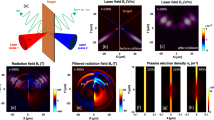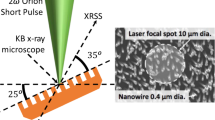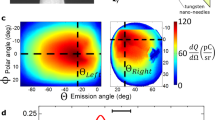Abstract
The heating of dense matter to extreme temperatures motivates the development of powerful lasers1,2,3,4. However, the barrier the critical electron density imposes to light penetration into ionized materials results in the deposition of most of the laser energy into a thin surface layer at typically only 0.1% of solid density. Here, we demonstrate that trapping of femtosecond laser pulses of relativistic intensity deep within ordered nanowire arrays can volumetrically heat dense matter into a new ultrahot plasma regime. Electron densities nearly 100 times greater than the typical critical density and multi-keV temperatures are achieved using laser pulses of only 0.5 J energy. We obtained extraordinarily high degrees of ionization (for example, 52 times ionized Au) and gigabar pressures only exceeded in the central hot spot of highly compressed thermonuclear fusion plasmas. Scaling to higher laser intensities promises to create plasmas with temperatures and pressures approaching those in the centre of the Sun.
This is a preview of subscription content, access via your institution
Access options
Subscribe to this journal
Receive 12 print issues and online access
$209.00 per year
only $17.42 per issue
Buy this article
- Purchase on Springer Link
- Instant access to full article PDF
Prices may be subject to local taxes which are calculated during checkout




Similar content being viewed by others
References
Glenzer, S. H. et al. Symmetric inertial confinement fusion implosions at ultra-high laser energies. Science 327, 1228–1231 (2010).
Fujiota, S. et al. X-ray astronomy in the laboratory with a miniature compact object by laser-driven implosion. Nature Phys. 5, 821–825 (2009).
Robey, H. F. et al. Hohlraum-driven mid-Z (SiO2) double-shell implosions on the Omega Laser Facility and their scaling to NIF. Phys. Rev. Lett. 103, 145003 (2009).
Glenzer, S. H. et al. Cryogenic thermonuclear fuel implosions on the National Ignition Facility. Phys. Plasmas 19, 1228–1231 (2012).
Fournier, K. B. et al. Efficient multi-keV X-ray sources from Ti-doped aerogel targets. Phys. Rev. Lett. 92, 165005 (2004).
Matthews, D. L. et al. Characterization of laser produced plasma X-ray sources for use in X-ray radiography. J. Appl. Phys. 54, 4260–4268 (1983).
Foord, M. E. et al. Ionization processes and charge-state distribution in a highly ionized high-Z laser-produced plasma. Phys. Rev. Lett. 85, 992–995 (2000).
Heeter, R. F. et al. Benchmark measurements of the ionization balance of non-local- thermodynamic-equilibrium gold plasmas. Phys. Rev. Lett. 99, 195001 (2007).
Young, B. K. F., Wilson, B. G., Price, D. F. & Stewart, R. E. Measurement of X-ray emission and thermal transport in near-solid-density plasmas heated by 130 fs laser pulses. Phys. Rev. E 58, 4929–4936 (1998).
Guethlein, G., Foord, M. E. & Price, D. Electron temperature measurements of solid density plasmas produced by intense ultrashort laser pulses. Phys. Rev. Lett. 77, 1055–1058 (1996).
Theobald, W. et al. Hot surface ionic line emission and cold K-inner shell emission from petawatt-laser-irradiated Cu foil targets. Phys. Plasmas 13, 043102 (2006).
Hobbs, L. M. et al. Demonstration of short pulse laser heating of solid targets to temperatures of 600 eV at depths of 30 µm using the Orion high power laser. Bull. Am. Phys. Soc. 57, 156 (2012).
Huntington, C. M. et al. Spectral analysis of X-ray emission created by intense laser irradiation of copper materials. Rev. Sci. Instrum. 83, 10E114 (2012).
Ditmire, T. et al. High-energy ions produced in explosions of superheated atomic clusters. Nature 386, 54–56 (1997).
Murnane, M. M. et al. Efficient coupling of high-intensity subpicosecond laser pulses into solids. Appl. Phys. Lett. 62, 1068–1070 (1993).
Gordon, S. P., Donnelly, T., Sullivan, A., Mamster, H. & Falcone, R. W. X-rays from microstructured targets heated by femtosecond lasers. Opt. Lett. 19, 484–487 (1994).
Rajeev, P. P. Taneja, P., Ayyub, P., Sandhu, A. S. & Kumar, G. Metal nanoplasmas as bright sources of hard X-ray pulses. Phys. Rev. Lett. 90, 115002 (2003).
Sumeruk, H. A. et al. Control of strong-laser-field coupling to electrons in solid targets with wavelength-scale spheres. Phys. Rev. Lett. 98, 045001 (2007).
Khattak, F. Y. et al. Enhanced He-α emission from ‘smoked’ Ti targets irradiated with 400 nm, 45 fs laser pulses. Europhys. Lett. 72, 242–248 (2005).
Kulcsár, G. et al. Intense picosecond X-ray pulses from laser plasmas by use of nanostructured ‘velvet’ targets. Phys. Rev. Lett. 84, 5149–5152 (2000).
Mondal, S. et al. Highly enhanced hard X-ray emission from oriented metal nanorod arrays excited by intense femtosecond laser pulses. Phys. Rev. B 83, 035408 (2011).
Ovchinnikov, A. V. et al. Characteristic X-rays generation under the action of femtosecond laser pulses on nano-structured targets. Laser Particle Beams 29, 249–254 (2011).
Nishikawa, T., Suzuki, S., Watanabe, Y., Zhou, O. & Nakano, H. Efficient water-window X-ray pulse generation from femtosecond-laser-produced plasma by using a carbon nanotube target. Appl. Phys. B 78, 885–890 (2004).
Brunel, F. Not-so-resonant, resonant absorption. Phys. Rev. Lett. 59, 52–55 (1987).
Prieto, A. L. et al. Electrodeposition of ordered Bi2Te3 nanowire arrays. J. Am. Chem. Soc. 123, 7160–7161 (2001).
Busquet, M., Pain, D., Bauche, J. & Luc-Koenig, E. Study of X-ray spectrum of laser-produced Au plasmas. Phys. Scripta 31, 137–148 (1985).
MacGowan, B. J. et al. Laser–plasma interactions in ignition scale Hohlraum plasmas. Phys. Plasmas 3, 2029–2040 (1996).
Pukhov, A. Three-dimensional electromagnetic relativistic particle-in-cell code VLPL (Virtual Laser Plasma Lab). J. Plasma Phys. 61, 425–433 (1999).
Zhidkov, A. & Sasaki, A. Effect of field ionization on interaction of an intense subpicosecond laser pulse with foils. Phys. Plasmas 7, 1341–1344 (2000).
Karmakar, A. & Pukhov, A. Collimated attosecond GeV electron bunches from ionization of high-Z material by radially polarized ultra-relativistic laser pulses. Laser Particle Beams 25, 371–377 (2007).
Acknowledgements
This work was supported by a Defense Threat Reduction Agency grant (HDTRA-1-10-1-0079) and by the HEDLP programme of the Office of Science of the US Department of Energy. The experiments were conducted at facilities from the National Science Foundation (NSF) ERC for Extreme Ultraviolet Science and Technology at Colorado State University using equipment develop under NSF grant MRI-ARRA 09-561. A.P. acknowledges support from DFG funded project TR18. The authors acknowledge the contributions of D. Ryan, C. Benton, A. Nobel and M. Woolston in relation to the experimental set-up, E. Jackson for nanowire target fabrication and C. Menoni and D. Patel for providing high-damage-threshold coatings. The authors thank J. Reader, J. Gillaspy, A. Kramida and J. Curry from NIST, Gaithersburg, for providing the atomic spectral data used to interpret the spectra, and R. London, R. Lee and M. Schneider for discussions and references.
Author information
Authors and Affiliations
Contributions
V.N.S. and J.J.R. conceived the experiment. A.Pu. developed the PIC model and performed the simulations. J.J.R. and M.A.P. designed the experiment. M.A.P., R.H., C.B. and J.J.R. carried out the experiment and acquired the data. Y.W., B.M.L. and J.J.R. developed the ultrashort pulse laser. Y.W., L.Y. and S.W. contributed to making the laser operational for the experiments and R.H., A.P. and C.B. developed the nanowire targets. V.N.S. conducted hydrodynamic simulations and V.N.S., A.Pu. and J.J.R. interpreted the simulations. M.A.P., J.J.R., V.N.S. and A.Pu. wrote the paper, with contributions from the other authors.
Corresponding author
Ethics declarations
Competing interests
The authors declare no competing financial interests.
Supplementary information
Supplementary information
Supplementary information (PDF 630 kb)
Rights and permissions
About this article
Cite this article
Purvis, M., Shlyaptsev, V., Hollinger, R. et al. Relativistic plasma nanophotonics for ultrahigh energy density physics. Nature Photon 7, 796–800 (2013). https://doi.org/10.1038/nphoton.2013.217
Received:
Accepted:
Published:
Issue Date:
DOI: https://doi.org/10.1038/nphoton.2013.217



